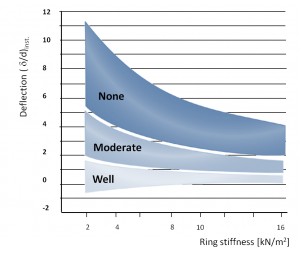PRO & FLO Structural Design
Under general gravity drainage pipe laying conditions, detailed calculations predicting pipe performance are not necessary. Following an extensive study of installed pipe performance, the European Plastic Pipe and Fitting Association (TEPPFA) concluded that the final deflection of pipes was controlled by the settlement of the soil after installation. Where installation was controlled, or self-compacting granular material were used, pipe deflections were consistently low regardless of installation depth and traffic or other loads. In the graph below, “Well” compacted refers to Standard Proctor of >94% and “Moderate” compaction refers to Standard Proctor of 87-94%.

The graph shows deflection immediately after installation. Final pipe deflection after soil settlement are expected to be 1% higher for well compacted granular soil, 2% for moderately compacted granular soil and 3-4% where no compaction has taken place.
Where pipes are to be installed in normal conditions at depths up to 6m such that the depth to diameter ratio is at least 2, design calculations are not required. Simply following the recommended installation procedures will ensure that deflections are controlled. This is particularly true for installations under roadways, where the level of compaction required to prevent subsidence of the pavement also provides a highly supportive structural environment for the pipe.
For unusual conditions, or depths greater than 6 metres, design calculations may be performed in accordance with AS/NZS 2566.1. The structural design aspects of buried flexible pipes to be considered are vertical deflection, ring bending strain and buckling.
The following typical values may be used in pipe design:
| Property | Symbol | Value |
| Short term Stiffness – StormPRO® /StormFLO® | SDI | 8,000 N/m/m |
| Allowable Long Term Deflection | 7.5% | |
| Allowable Long Term Ring Bending Strain | εball | 4% |
| Long Term Stiffness – StormPRO® Long Term Stiffness – StormFLO® |
SDL2 | 1,550 N/m/m 3,900 N/m/m |

